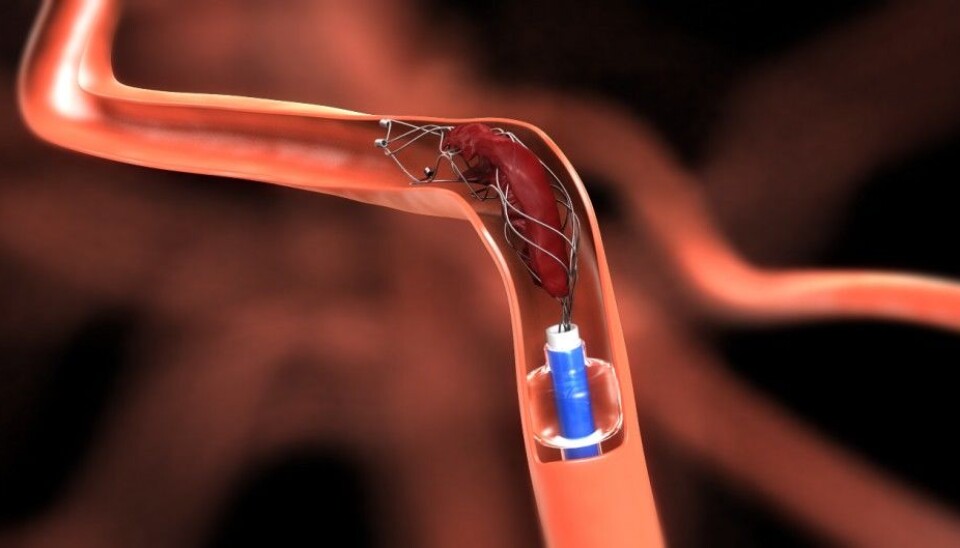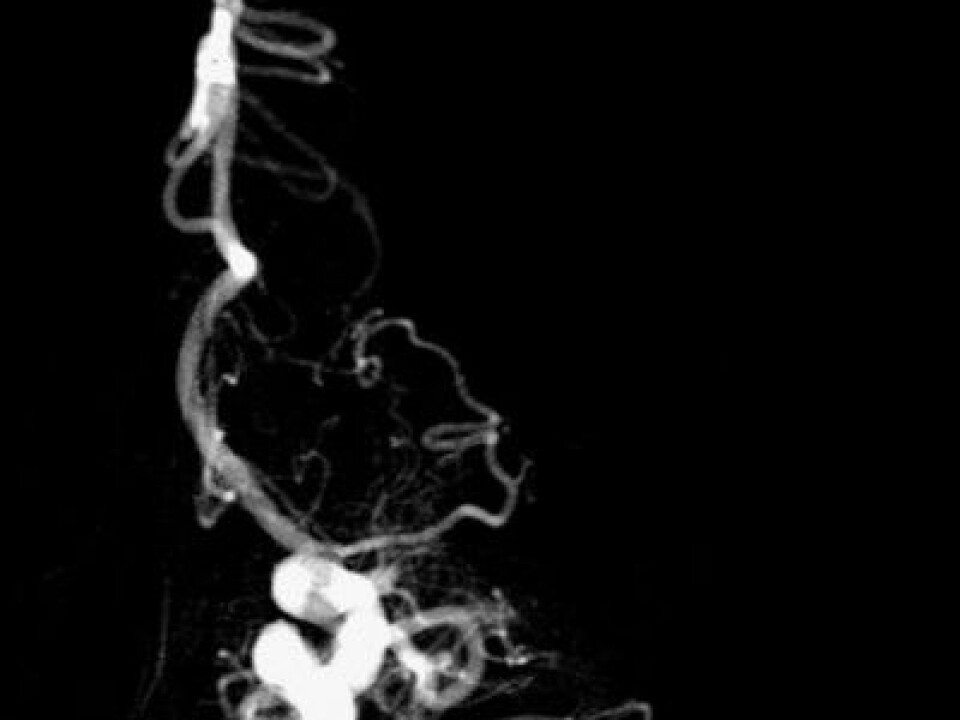
Fishing for blood clots will help more stroke victims
A new procedure to remove blood clots from stroke victims’ brains will now be available to more patients. The method is more efficient and can save more lives than other types of medication. But the decision has been “scandalously slow” in coming, says senior physician and professor.
More patients suffering from strokes due to blood clots will now be able to undergo a form of treatment that catches the blood clot in a thin net and fishes it out. Norway’s Decision forum in the National system for managed introduction of new health technologies within the specialist health service has just approved this procedure as a standard treatment method for severely affected patients.
"This method is the second revolution for stroke treatment. Clot-busting medicine was the first revolution," Professor Lars Thomassen at the University of Bergen (UiB) tells forskning.no.
He is also a senior physician at the Centre for Neurovascular Diseases in the Department of Neurology at Haukeland University Hospital in Bergen.
He initiated a methods review two years ago, but is discouraged that the decision to expand treatment options in Norway has taken so long.
“Scandalously slow”

The decision was based on two Norwegian reports that compared the effect of mechanical thrombectomy with the more traditional thrombolysis treatment using drugs called clot-busters. The reports showed that mechanical thrombectomy is an effective and safe treatment for patients with acute ischemic strokes due to blood clots, according to Dagens Medisin.
The Knowledge Centre at the Norwegian Institute of Public Health only released the second report in January of this year, showing treatment costs and that the procedure saved lives.
Thomassen is frustrated that the process has taken so long, and refers to international studies that have shown positive treatment results for a long time.
"I think the process has been scandalously slow. This is a dramatically effective treatment for those who need it. Many patients have suffered more brain damage and function failure than they would have if the thrombectomy procedure had been available to them," says Thomassen.
Fishing rod is better than “Drāno”
Thomassen believes it is obvious that mechanical thrombectomy is a better form of treatment than dissolving clots with medication. One reason is that chemical dissolution of large blood clots takes a long time.
"My point is that a fishing rod is better than "Drāno," he says. "Chemical substances gradually break down a blood clot, but the bigger it is, the longer it takes," says the professor.
Thrombolysis – the chemical approach – works best on coagulated blood. But large blood clots in the brain usually also contain calcium and cholesterol, which dissolve less readily, he explains.
Less function loss
The most common kind of stroke is caused by a clot or other blockage in an artery leading to the brain. The blood clot usually originates in the heart or carotid artery. Only in 15 per cent of cases is stroke caused by the sudden rupture of an artery in the brain.
Mechanical thrombectomy has a lower probability of function loss in patients three months after they suffered a stroke, according to the reports.
The reports also show that the fishing method provides more quality-adjusted life-years than drug treatment alone. But increasing the availability of the thrombectomy option requires reorganizing the healthcare system and more equipment, and entails significant costs.
Method has been improved
The method involves inserting a catheter – containing a small instrument that resembles a very thin fishing net on the end of a metal wire – into the femoral artery, and guiding it to where the clot is located in the brain. Thomassen notes that it took about five years for the method to become noticeably better. Researchers have tried out improved "fishing rods," which makes the procedure safer and faster than before.
"The first method was to try to squeeze a cork into the clot and then pull it out – but this took a lot of fiddling. Then the method was improved by catching the blood clot in a net, so you can pull it out faster,” says Thomassen.
The net allows blood flow around the clot to resume more quickly by squeezing the clot and reducing the amount of injury while extracting it. This improvement was made in 2013.
As early as 2014, studies from Europe were pouring in, showing that the method had been significantly improved, according to Thomassen.
He contacted the Norwegian health authorities in early 2015 to expedite a change in treatment practises, so that more stroke patients could get better help.
Can help a thousand patients per year
The decision means that far more patients will now have access to better treatment. Last year, 150 patients with severe stroke underwent thrombectomy treatment in Norway – only two per cent of severe stroke victims.
"We expect to be able to increase this to 10 per cent or more, to 750 or 1000 patients," Thomassen says.
So far, mechanical thrombectomies have only been performed at the university hospitals in Oslo, Bergen, Stavanger, Trondheim and Tromsø.
By comparison, 18 per cent of the stroke patients in Switzerland the mechanical procedure. The biggest challenge will be to prioritize who will get help.
Depending on where a patient lives, one has to gauge whether someone should go to the nearest hospital for medication treatment first, or be flown directly to a hospital offering thrombectomies.
"This can quickly lead to a centralization debate, which is a touchy subject," says Thomassen.
Age plays less of a role than what condition the patient is in when the stroke occurs.
"The better physical shape a person is in before the stroke, the better the patient can tolerate the procedure," says Thomassen. Patients ranging from 20 all the way up to 90 years old.
“Now it will be up to the regional health authorities to determine how many new places this will be done,” Decision forum chair Lars Vorland told Dagens Medisin.
The cost is peanuts
According to the health economics analysis put out in January this year, it will cost NOK 10 million to establish mechanical thrombectomy treatment at two new centres. Nevertheless, it will pay off in the number of patient years saved.
"The costs of increasing the new treatment are still peanuts compared to new cancer medicines,” Thomassen says.
If 10 per cent of severe stroke victims in Norway – or 1000 people per year – receive this treatment, it will result in a cost of NOK 77 000 per quality-adjusted life-year.
The calculation assumes that patients are treated within five hours of the first symptoms.
Cancer treatments approved faster
Thomassen believes it’s a problem that health authorities are quicker to introduce new cancer drugs than they are to implement new stroke treatment options.
Media pressure is part of the explanation, he thinks, because “cancer affects younger people more often, and the marketing value of stroke isn’t as high.
-------------------------------------
Read the Norwegian version of this article at forskning.no
































